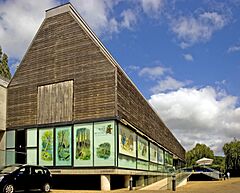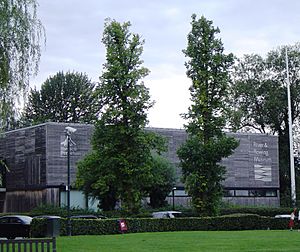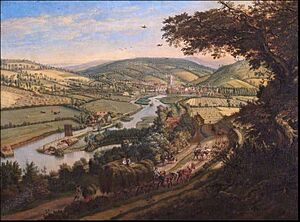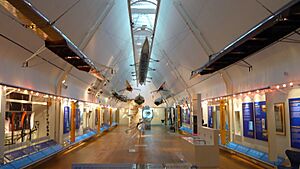River and Rowing Museum facts for kids

View of the museum from the car park
|
|
| Established | 1998 |
|---|---|
| Location | Mill Meadows, Henley-on-Thames, England |
| Type | Local and sports museum |
| Collections | Rowing, River Thames, Henley-on-Thames |
| Founder | David Lunn-Rockliffe |
| Architect | Sir David Chipperfield |
| Historian | Chris Dodd |
| Nearest parking | Own car park |

The River & Rowing Museum was a special place in Henley-on-Thames, Oxfordshire, England. It was right by the River Thames at Mill Meadows. The museum explored three main topics: the River Thames, the sport of rowing, and the history of Henley-on-Thames itself.
The museum's trustees announced its closure on February 27, 2025, due to financial challenges.
Contents
History of the Museum
The idea for the museum came mostly from David Lunn-Rockliffe. He used to be a leader at the Amateur Rowing Association.
Award-Winning Building
The museum building was designed by a famous architect, Sir David Chipperfield. It won awards for its design. In 1999, it received the Royal Fine Art Commission Building of the Year award. It was also named the UK National Heritage Museum of the Year in 1999.
Queen Elizabeth II officially opened the museum in November 1998. Important supporters included The Arbib Foundation and Urs Schwarzenbach.
The Wind in the Willows Attraction
In 2004, a fun The Wind in the Willows exhibit was added for families. It was a walk-through experience with models and sets. An audio-guide helped visitors explore the world of the 1908 book by Kenneth Grahame. The exhibit brought to life the illustrations by E.H. Shepard.
Rowing Gallery Upgrade
In 2006, the museum made its Rowing Gallery even better. This was possible thanks to a large gift from Urs Schwarzenbach. The gallery became known as the Schwarzenbach International Rowing Gallery. It showed the history of rowing from ancient Greece to the modern Olympics.
The gallery had sections about the Oxford versus Cambridge Boat Race. It also covered World and Olympic rowing. Visitors could learn about professional rowing from the past. There were displays on building boats, coaching, and healthy eating for rowers. The museum also showed many unique video clips. A cool part of the gallery was an interactive exhibit called In the Cox's Seat. Here, visitors could sit in a real rowing boat. They could experience what it felt like to race at Henley Royal Regatta.
Special Art Exhibitions
The museum often hosted temporary art shows. These included works by local artists like Chris Gollon and John Piper. There were also exhibitions by potter Geoffrey Eastop and furniture maker Philip Koomen. In 2006, John Piper's grandson, Luke Piper, had an exhibition. From November 2006 to February 2007, there was a show about E.H. Shepard's illustrations. It was called The Man who Drew Pooh & Toad.
The museum was one of the first to have its own website. It was online even before the building opened.
Museum Themes
The museum explored four main themes through its galleries and special events:
- The River Thames: its past, present, and future.
- The town of Henley on Thames: its history as a riverside community.
- Rowing: the international sport.
- The Wind in the Willows: the famous children's book.
Museum Galleries
The Wind in the Willows Gallery
This permanent exhibition brought the characters of The Wind in the Willows to life. Visitors could see Mr Toad, Ratty, Badger, and Mole. The setting was based on the River Thames, which inspired the book.
The exhibition used 3-D models based on E.H. Shepard's original drawings. Shepard explored the areas around Pangbourne to find ideas for his illustrations. The exhibit followed the book's story. Special lighting and sounds made visitors feel like they were part of the world of The Wind in the Willows. Interactive displays and audio guides helped make the story real.
Thames Gallery
The Thames Gallery was the largest permanent gallery at the museum. It told the story of the River Thames from its start to the sea. The River Thames is very important to life in the Thames Valley and all of England.
The gallery showed many different sides of the river. It explored how the river inspired art and how it is a home for wildlife. It also showed how the river was used for fun and for trade. The gallery used music, art, photos, real objects, boats, and stories from people. It took visitors on a journey from the river's source at Kemble to the Thames Barrier. Displays showed the river's history and social importance. Interactive screens helped visitors learn about managing the river and water supply.
Things you could learn about the Thames included:
- Travel from its hidden source to the sea.
- Paintings of the Thames.
- The wildlife and insects living in and by the river.
- Music, poems, and books inspired by the Thames.
- The skill of boat builders, from old log boats to modern skiffs.
- How the Thames has been managed over time.
- The importance of weirs, locks, and bridges.
- Stories from people who lived by the river.
Schwarzenbach International Rowing Gallery
At the entrance, there was a painting called Gollon At Henley by Chris Gollon. The museum asked him to paint it in 2008. It showed a rowing crew after losing a race at Henley Royal Regatta. Inside the gallery, the story of international rowing was told. Visitors could experience what it felt like to compete on the water.
Rowing is one of the world's oldest sports. The gallery explained its history in detail. Many objects that had never been seen by the public were on display. There were also films of races and interactive exhibits.
Sections included:
- Six communities that used oars for their work.
- A 360° view of a race at the Henley Royal Regatta.
- Rowing around the world and through the centuries.
- Races at the Olympics and the Boat Race.
- Professional rowers, who were sports stars in their time.
- Coaches and boat builders who helped champions succeed.
- Racing boats showing 200 years of design changes.
The Henley Gallery
The Henley Gallery told the story of the town of Henley-on-Thames. This town grew up by the river. Its history included industry, arts, the Civil War, and sports. An interactive screen let visitors take a virtual tour of Henley's streets. They could go back in time to when the town started. They could see how it changed and how it became famous for rowing.
In 2009, the museum bought a collection of Iron Age coins. There were 32 gold coins from around 50 AD. They were found in Henley in 2003. This was the only collection of British-made Iron Age coins from Oxfordshire found still together. The museum bought them with the Ashmolean Museum in Oxford.
Henley started in the 1100s. Its location by the river made it a good port. It shipped timber, grain, and firewood to London, which was growing fast. From then on, the town's success was linked to the river and transport. Boats, stagecoaches, trains, and cars all brought goods and people to the town for business and fun.
The Henley Royal Regatta made Henley-on-Thames a world-famous rowing center. It started in 1839 and got royal support in 1851. The Regatta brings together top international rowers. It is also a well-known event in the English social calendar. Films in the gallery showed town and Regatta celebrations since 1899.

A painting from 1698, Henley from the Wargrave Road, had its own room. It was painted by the Dutch artist Jan Siberechts. This painting showed the many parts of life in the town and countryside. It was one of Siberechts' English landscapes. The painting recorded social history, showing river trade, farming, and social classes. It also showed a view of the town that still looks familiar today. The museum bought this painting with help from the National Art Collections Fund and the Heritage Lottery Fund.
Special Exhibitions
The Treasures Gallery, Sir Graham Kirkham Gallery, and The Wall were used for special exhibitions. The museum's exhibition program focused on its main themes. It included shows for families and more specialized exhibits. Topics ranged from big events and anniversaries to art, crafts, sculpture, or deep dives into specific subjects.


